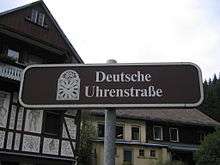German Clock Road

Sign in Lenzkirch
The German Clock Road (German: Deutsche Uhrenstraße) or German Clock Route is a holiday route that runs from the Central Black Forest through the Southern Black Forest to the Baar region and thus links the centres of Black Forest clock manufacturing.
Towns, villages and counties
The towns and villages along the route (in alphabetic order) are: Deißlingen, Eisenbach, Furtwangen, Gütenbach, Hornberg, Königsfeld, Lauterbach, Lenzkirch, Niedereschach, Rottweil, Schönwald, Schonach, Schramberg, Simonswald, St. Georgen, St. Märgen, St. Peter, Titisee-Neustadt, Triberg, Trossingen, Villingen-Schwenningen, Vöhrenbach, Waldkirch
The counties through which the German Clock Road runs are: Schwarzwald-Baar, Breisgau-Hochschwarzwald, Rottweil, Tuttlingen, Emmendingen and Ortenau
Attractions en route
With a clock theme

One of the world's largest cuckoo clocks in Schonach
- German Clock Museum in Furtwangen with the largest collection of clocks in Germany
- Museum of Clockmaking in Villingen-Schwenningen which focusses on the history of clock manufacture
- Largest cuckoo clock in the world in Schonach
- Gütenbach Village Museum with many clocks by local clockmakers
- St. Märgen Abbey Museum, which portrays the development of the Black Forest clock and Black Forest clock dealers abroad
- ErfinderZeiten Museum in the car and clock world in Schramberg with an emphasis on the Schramberg clock factory of Junghans as well as the development of the Black Forest clock industry in general
Other attractions
- Triberg Waterfalls, which is one of the highest and best known waterfalls in Germany
- Black Forest Railway, a technically unusual mountain railway with 40 tunnels
- Titisee, the largest natural lake in the Black Forest
- Baroque churches and abbeys in St. Märgen and St. Peter
- German Harmonica Museum in Trossingen
Weblinks
This article is issued from Wikipedia - version of the 10/10/2016. The text is available under the Creative Commons Attribution/Share Alike but additional terms may apply for the media files.